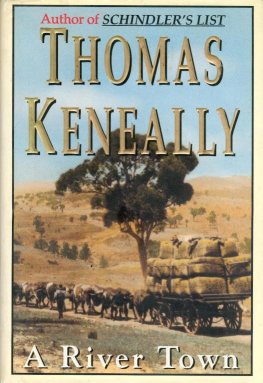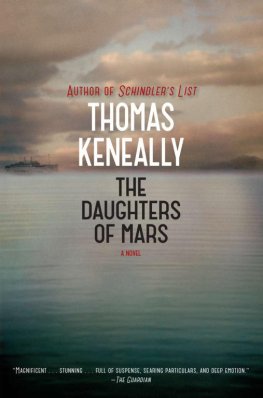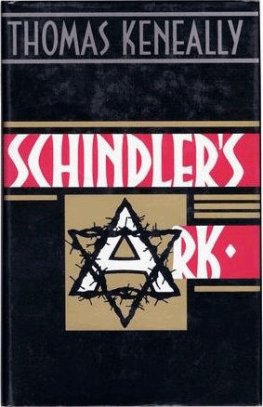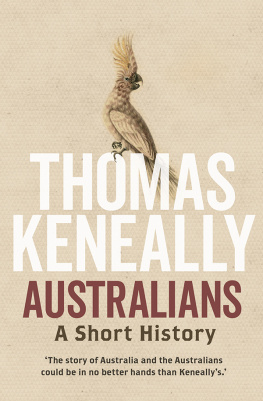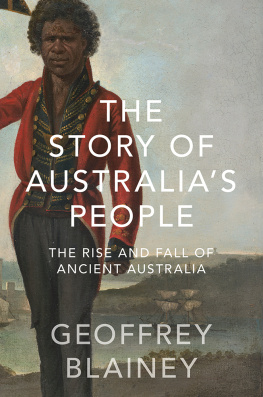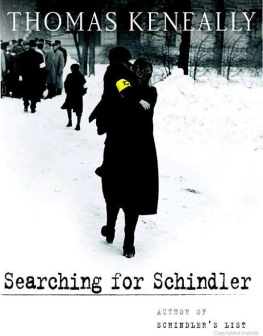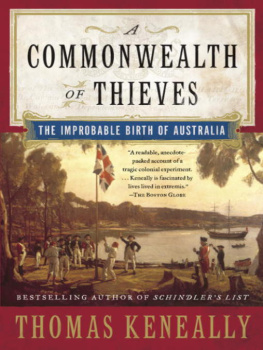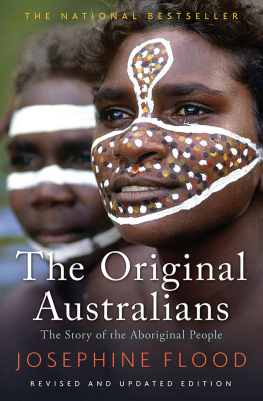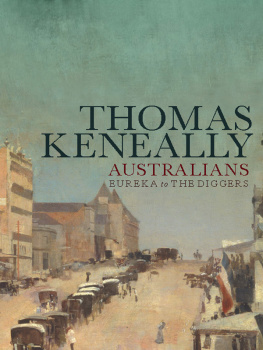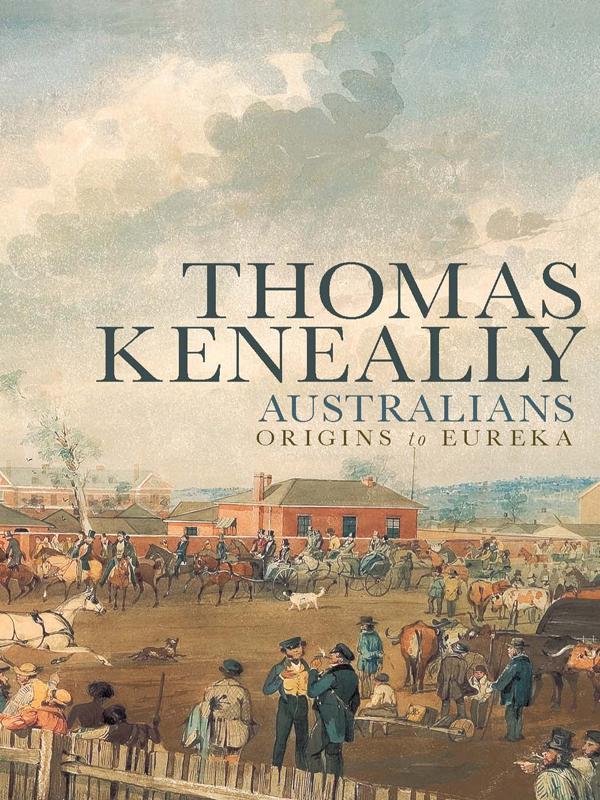
THOMAS
KENEALLY
AUSTRALIANS
THOMAS
KENEALLY
AUSTRALIANS
ORIGINS to EUREKA
VOLUME 1

First published in Australia in 2009
Copyright Thomas Keneally 2009
All rights reserved. No part of this book may be reproduced or transmitted in any form or by any means, electronic or mechanical, including photocopying, recording or by any information storage and retrieval system, without prior permission in writing from the publisher. The Australian Copyright Act 1968 (the Act) allows a maximum of one chapter or 10 per cent of this book, whichever is the greater, to be photocopied by any educational institution for its educational purposes provided that the educational institution (or body that administers it) has given a remuneration notice to Copyright Agency Limited (CAL) under the Act.
Allen & Unwin
83 Alexander Street
Crows Nest NSW 2065
Australia
Phone: (61 2) 8425 0100
Fax: (61 2) 9906 2218
Email: info@allenandunwin.com
Web: www.allenandunwin.com
Cataloguing-in-Publication entry is available from the National Library of Australia
www.librariesaustralia.nla.gov.au
ISBN 978 1 74175 0690
Typeset in Minion 11.5/15pt by Midland Typesetters, Australia Printed in Australia
by Ligare Book Printer
10 9 8 7 6 5 4 3 2 1
To four young Australian inheritors of history,
Augustus, Clementine, Alexandra and Rory.
CONTENTS
The idea for this book arose from an editorial meeting, chaired by Patrick Gallagher at Allen & Unwin. So the author owes thanks to all at that table. I must also thank:
Dr Olwen Pryke, gifted researcher on this book, who has now gone on to better things at the State Library of New South Wales;
Judy Keneally, my manuscript- and proof-reading spouse, always a wise reader;
Fiona Inglis, amiable agent, for supporting me through the process and making the contract;
Rebecca Kaiser, a very genial editor-in-chief;
Amanda OConnell, thorough and percipient copy editor;
Linda Brainwood, tireless picture researcher;
Lisa White, who designed a beautiful book;
And Kathy Mossop, Jo Lyons and Karen Ward who finally herded these pages into one pasture.
Best wishes to them all.
Thomas Keneally
In this book Ive tried to tell the stories of a number of Australians from the Pleistocene Age to 1860. The people whose tales are told here exemplify the major aspects and dynamisms of the Australian story. For each one I chose to write about, I could have chosen a dozen, a hundred, or in some cases, thousands more. This history therefore sets out to characterise Australia and, above all, individual Australians, in a manner which gives insight into the most significant aspects of the periods I deal with without exhaustively and thus cursorily engaging with every major actor. For example, a number of the explorers are dealt with in salient though not as thorough detail as some others are. The same is true of governors. It is in many cases with the question of how governors impacted upon individuals living on this continent that this book frequently prefers to concern itself. There are some instances where I have used material from my earlier books, The Great Shame and The Commonwealth of Thieves. I hope that those who are kind enough to read this book find this material altered to give them new perspectives, not too reminiscent of these works. I also hope that through following these histories of particular, though sometimes obscure, individuals, and by examining infrequently reported aspects of the lives of the well-known, I have managed to cast light on at least some of the mysteries of the Australian soul.
DINNER AT CUDDIE SPRINGS
Once there was the All-Sea. Its brew of water and minerals and biology covered the planet. Then the first stones, sediments and bacteria of the great landmass Pangaea broke the surface of the encompassing ocean. They can still be found, these first gestures of ground, the original Mother Earth, in the Pilbara region of Western Australia. The question of whether Australia is old or young jangles in the Australian imagination.
At Taronga Zoo in Sydney there is a globe, at child height, showing Pangaea, the great agglomerated landmass, which remained one huge slab of earth for so long and began to break apart only about 140 million years ago. Pangaea is shown at the zoo in cut sections. A child can move the solid shapes which once made up the enormous single earth-mass on grooves, to create Laurasia in the north and Gondwana, the great southern super-continent. Then, further grooves on the surface enable the child to separate Gondwana into India, Africa, South America, Antarctica and Australia, and slide them to their present locations on the globe. Each of the pieces on this globe is marked with graphics, and as the god-playing child separates Australia from the massive Gondwana, he or she can see pictures of Australian fauna and mega-fauna abandoning the old mother super-continent, choosing Australia as their Mesozoic zoo. The separation of Australia from the rest of Gondwana began 45 million years ago.
It was not all quite as clean as the zoo game indicates. The exotic separating fragment included a version of Australia, New Guinea and Tasmania in the one gigantic landmass, named Sahul by paleontologists. It was all far to the south of where it is now. Over the next fifteen million years, Sahul edged northwards, striving, but not fully managing till three million years ago, to separate itself broadly from the Antarctic and assume a position in the primeval Pacific.
To add to the complicated picture, at various stages Sahul shrank and then expanded again. It was fifteen million years ago, for instance, that Tasmania first became an island, but then, dependent on sea levels, Sahul would regularly take it back into its mass again. The last time Tasmania separated was only 11 000 years ago, when Homo sapiens was already occupying the region, at the end of the Great Ice Age.
But Taronga Zoos idea of exotic animals skipping over water to get on board Sahul/Australia is a potent one. It tells the child that Australia is the continent of exotics and grotesques, and the unique story of the country surely reflects that notion for adults, too.
Modern dating methods show that the arrival of the first Australians occurred at least 60 000 years Before the Present (BP). The people who became the natives of the Australian continent first crossed from the prehistoric south-east Asian district named Wallacea between 60 000 to 18 000 BP, when the Arafura Sea was an extensive plain, when sea levels were 30 metres below where they are now, and there was a solid land bridge some 1600 kilometres wide between Australia and New Guinea, then joined within Sahul. Sahuls north-western coast received only small numbers of individuals from the islands of Wallacea, possibly as few as fifty to one hundred people over a decade.
They may have come by log or canoe; they may even have waded to Sahul at low tide. If experts on human language can be believed, our species had not at that stage achieved speech, but some means of creating human co-operation would have been needed.
Descendants of these first comers still live by the hundreds of thousands in Australia, and the picture of how they lived and what they did with the continent has been revised again and again in recent times. In the early 1960s the proposal that Aboriginal people had lived in Australia for 13 000 years was thought fanciful. But carbon dating showed campfires and tools to be at least 30 000 years old, and these days experts use luminescence dating to claim that campfires and firestick burning date from more than 100 000 years ago. Almost at once as this claim was made, in 1996, at Jinmium in the Northern Territory, Australian scientists dated stone tools as 130 000 years old. If they are right, the original Australians are the oldest race on the planet. Similar remains of human activity, from before the last Ice Age, have been found on the Great Barrier Reef, on an earlier coastal line of cliffs now swamped by ocean.
Next page


